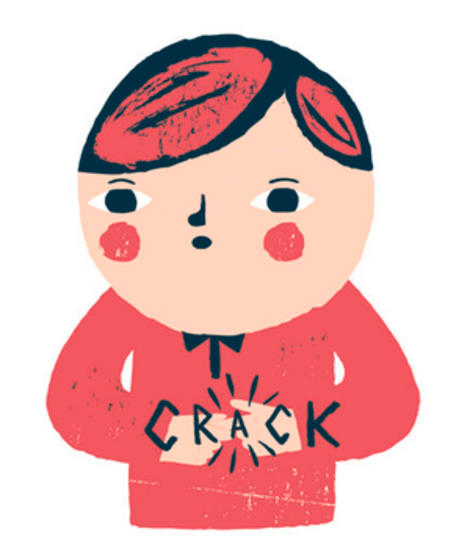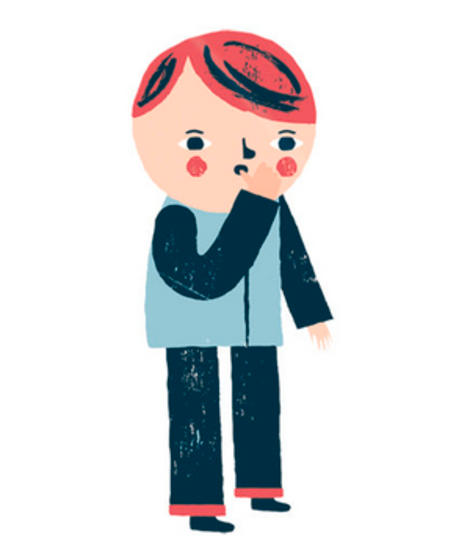How to Stop Kids from Biting Their Nails, Sucking Their Thumbs, and More
Your kids' little quirks make you, well, want to start biting your nails. Help them overcome unseemly behaviors with some expert advice.
By Jennifer King Lindley
How to Break a Bad Habit
You adore your child, but you can't say the same about some of his annoying habits: The knuckle cracking. The nail nibbling. The way he interrupts your phone calls with emergency pleas for peanut butter. Relax-there are a few wise strategies to restore your sanity.

First, it's important to understand the impulse behind the actions. If he's smacking away at the dinner table, he may just need an etiquette adjustment. However, some parental button-pushers-like thumb-sucking, nail biting, knuckle cracking, and hair twirling-are unconscious ways to relieve tension. "They can help alleviate feelings that a child is experiencing in a big way-boredom, anxiety, overexcitement," says Dawn Huebner, Ph.D., a psychologist in Exeter, New Hampshire, and the author of What to Do When Bad Habits Take Hold ($16, amazon.com).
A gentle approach is best. "Shaming or punishing him may just compound the stress that's feeding these habits in the first place," says Jack Maypole, M.D., the director of pediatrics at the South End Community Health Center, in Boston. Instead, he says, try to point out the appeal of giving up the behavior. If he clings to the thumb, for instance, say, "You're a big kid now, and I don't think big kids do that anymore."
Since these activities often fill an important sensory need, says Huebner, help your child find a substitute. Don't underestimate the power of incentives. If she goes a day without biting her nails, let her choose dinner. And for every success, praise lavishly. "A little 'whoop-de-do!' is as much a reward as anything," says Maypole.
Finally, be patient. "Kids can be trying really hard," says Huebner, "and have a setback on a tough day." She notes that it can take 21 days of sustained effort to break a habit.
Also See: What Bad Habit Do You Wish You Could Break?

Nail Biting
Nail biting sometimes indicates Nervous Nellydom, but not always. Your child may start by innocently trying to nip away a hangnail; the nibbling can cause soreness, which draws her attention back to it. Genetics may also play a part. One 2005 Japanese study found the nail-biting tendency was more commonly shared by identical twins (who have all the same genes) than by fraternal twins.
The substitute: Munching on pumpkin seeds or dried fruit can satisfy the gnawing impulse. You can also give your child an emery board so she can gently file away when her nails call her name.
Also try: Protect the nails by covering them with cool neon bandages during times when she nibbles (such as on long car trips). Keep fingers busy with clay or Lego pieces. It can also help to give her hands soothing attention with a scented lotion. Or offer her a special salon manicure if she can grow out her nails.
More drastic measures: If nail biting is causing infections in the cuticle or comes on suddenly after a stressful event, like a move, consult your pediatrician. Relaxation techniques (see our guide on how to manage your child's stress) or even hypnosis can help.

Hair Twirling
Hair is a built-in security blanket, silky and comforting to the touch. For some twirlers, the habit may have a calming effect that helps them focus.
The substitute: If your child likes to helicopter her hair wildly in math class, supply her with a stash of rubber bands or string, which can be wound around the fingers (or dreamily tied in knots). Or let her play with a beaded necklace.
Also try: To reduce temptation until she kicks the habit, pull her hair back into a ponytail or even crop it into a sporty short cut.
More drastic measures: In a small percentage of cases, twirling can develop into trichotillomania, a rare condition in which a person pulls her hair out. If you notice bald spots or if your child seems to pluck hair obsessively rather than absentmindedly, consult your pediatrician.
Also See:Easy Hairstyles and Hair Care Basics

Knuckle Cracking
That impressive noise is caused by popping gas bubbles in the fluid surrounding the joints. It can, admittedly, feel satisfying (and even macho).
The substitute: Distract your child by giving him some Bubble Wrap to pop, then send him to another part of the house.
Also try: Finger exercises can be a quiet alternative to cracking, according to Greg Irwin, a finger-exercise expert (!) and the creator of the Finger Fitness Program. "They help develop strength and dexterity," he says. "Tell your kid they're like push-ups and sit-ups for your hands." Try finger bends: Press hands together, then gently bend all fingers over to the left, then to the right. (See more at handhealth.com.)
More drastic measures: If the problem persists, establish no-cracking zones, like the dinner table. But don't worry that your child is in for a whopping case of arthritis someday. One dedicated researcher, Donald Unger, M.D., published a study in Arthritis and Rheumatism in which he cracked only his left knuckles daily for 50 years and found no noticeable difference between his two arthritis-free hands.

Thumb-Sucking
"Nonnutritive sucking-pacifiers, fingers-is expected for babies and toddlers," says Joel H. Berg, D.D.S., the president of the American Academy of Pediatric Dentistry. First, it's instinctive, but then it's soothing. Most kids give it up by age 3 or 4. Eventually it could lead to buckteeth, an overbite, or jaw-alignment issues.
The substitute: Give your child a squishy ball, such as a Koosh, to fiddle with, especially when he's most likely to go for the thumb (like TV time).
Also try: Berg is no fan of the bitter paint-on preparations to deter thumb-sucking. "Kids will just wash it off, and I don't think they work well anyway," he says. "I have a conversation with the child. I'll show them photos of crooked teeth and say, 'I know you care about your smile, and we can work together on this.' " Parents should use only positive reinforcement, he says. "Don't make note of when he's sucking his thumb, only when he's not."
More drastic measures: A pediatric dentist can fit a child with an appliance, called a crib, to be worn around the clock. "These fit below the palate and make it impossible to create a seal," says Berg.

Interrupting Conversations
Curiously, the moment you get a phone call is the very second your child has to share her deep need for a piece of gum.
The substitute: Many parents tell a child to stop interrupting but in the same breath respond to the request. "Then the child learns the method is effective," says Emily Geizer, a parenting coach and a former preschool teacher in Chapel Hill, North Carolina. She recommends asking your child to put her hand on you when she wants attention and then putting your hand on hers so she knows that you've "heard." Says Geizer, "That demonstrates mutual respect and teaches patience."
Open-Mouthed Chewing
No one wants to dine with a child who looks like a front-loading washing machine on spin.
The substitute: "Explain that chewing with your mouth open makes people uncomfortable," says Arden Clise, the president of Clise Etiquette, in Seattle, who teaches manners to adults and kids. "Tell him that if his friends and classmates can see inside his mouth, they may lose their appetite and not want to eat with him anymore." Have a fun phrase you can repeatedly deploy. Clise is fond of "The hatch is open!" She also likes this trick from etiquette grande dame Letitia Baldrige: Put a mirror in front of the child at dinner.

Hogging the Spotlight
You arrange a rare adult get-together, and your tutu-clad 6-year-old takes that as her cue to stage Swan Lake on the coffee table.
The substitute: "When kids fear they're not going to get attention, they can become hams," notes Clise. Prepare the child by saying, " 'We're going to have some adults-only time, but first you'll have a chance to say hello and show your favorite toy to everybody,' " says Clise. "Give her a moment in the spotlight, then usher her off to watch her favorite video." Verdick's own ballerina used to hand out "tickets" to guests, to be collected at an appointed time before her performance. "That gave her a chance to get some praise, but she wasn't constantly getting up from the table to go dance," she says.
Failure to Make Eye Contact With Grown-Ups
"Eye contact with a handshake and a smile from a child really impresses adults," says Clise, who worries that this old-fashioned form of respect is becoming extinct.
The substitute: You can role-play at home (repeatedly, if necessary), then prepare your child for a visit to Cousin Edna by explaining what you expect: "I would like you to smile and say, 'Nice to see you!' " Upon arrival, a little coaching is fine, says Clise. ("Mary, what do we say?") For very shy kids, try this trick from Elizabeth Verdick, a coauthor of Dude, That's Rude! ($9, amazon.com): "Tell him to ask himself, What color eyes does the person have? Then he can take a look and find out."
You Might Also Like:
4 Easy Kid-Friendly Recipes
Organizing and Storage Solutions for Your Kids' Clutter
10 Vices That Aren't So Bad After All
